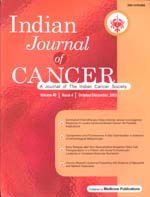
|
Indian Journal of Cancer
Medknow Publications on behalf of Indian Cancer Society
ISSN: 0019-509X EISSN: 1998-4774
Vol. 41, Num. 1, 2004, pp. 47
|
Indian Journal of Cancer, Vol. 41, No. 1, (January-March 2004) , pp. 47
Letter to Editor
Affordable Image Analysis using NIH
Image/ImageJ
Girish V,* Vijayalakshmi A
*Deparment of Preventive Medicine and Division of Haematology/Oncology,
Robert H.Lurie Comprehensive Cancer Center, Northwestern University Feinberg
School of Medicine, 710 North Fairbanks, Room 8340, Chicago, IL60611.
Correspondence to : Vijayalakshmi Ananthanarayanan. E-mail: viju@northwestern.edu
Code Number: cn04009
Sir,
The contribution of scientific technology in the field of
histopathology and lab medicine is well recognized. Image analysis is one such
division in which many researchers and practicing pathologists have used scientific
technology to good advantage. Currently there are many systems available to
an anatomic pathologist for the purpose of image analysis in immunohistochemistry
(IHC) and for nuclear morphometry. Many of these systems, however, require
expensive software and hardware attachments for image acquisition, analysis
and storage. Consequently, a cost-effective alternative for image analysis
would be a welcome tool for pathologists and researchers alike. In this connection, "ImageJ" is
a freely available java-based public-domain image processing and analysis program
developed at the National Institutes of Health (NIH). Currently, ImageJ's Macintosh
platform counterpart, "NIH Image" is widely used in biologic research.1-3
For the evaluation of IHC slides using ImageJ, images can
be captured onto the hard drive of the workstation computer. Thereafter, captured
images can be opened in NIH Image/ImageJ for evaluating indices of positivity
on IHC slides as well as fluorescence images.4,5 Counting can be
done in two ways off the image- the cell counter technique (analogous to the
hematology differential counters) and the area method. In the `cell counter
method', cells can be counted off directly from the screen by placing marks
of different colors onto positive and negative nuclei by mouse clicking. Finally,
ImageJ will generate the IHC index automatically. An advantage of this technique
over conventional counting across the microscope is its reproducibility and
accuracy. With the `area method', the total area occupied by positive (brown)
nuclei and negative (blue) nuclei can be estimated by setting a "threshold" using
ImageJ's thresholding tool for selection of these nuclei separately. From this
nuclear area data, the positive IHC index for that image can be calculated.
One another useful feature of ImageJ is the `ROI Manager' (Region Of Interest
Manager) where the pathologist can specify and draw out areas to be evaluated,
editing out the unwanted elements. All data can be imported into Microsoft
Excel worksheets to give a summated set of results for a single slide.
Besides IHC analysis, NIH Image/ImageJ can do densitometry
imaging to analyze intensity of western blot bands. In addition, a number of
nuclear
morphometric descriptors can be evaluated on
Feulgen-stained sections after downloading specific plug-ins
from the ImageJ website. The macros and plug-ins
are available as source files and download to the
ImageJ folder. The website gives step-by-step instructions
on how to execute the various available functions.
The latest PC (java) version, ImageJ.v1.31 can be downloaded from the web link
http://rsb.info.nih.gov/ij/ Sample images of gels, fluorescent cells and cell
colonies are included for learning the process of
analysis. Accessibility of the aforementioned web link has
been verified as of February 27, 2004.
In short, NIH Image/ImageJ delivers a lot despite being a
freeware. Knowledge of its potential uses will go a long way in establishing
objective, reproducible, cost-effective and timesaving methods of automated
image-based IHC evaluation and morphometry for histopathologists in our country.
ACKNOWLEDGEMENTS The authors wish to thank Wayne Rasband of the National Institute
of Mental Health (NIMH, NIH), the author of NIH Image/ImageJ, for his technical
assistance and expert review of the matter contained in this letter.
Girish V,* Vijayalakshmi A
*Deparment of Preventive Medicine and Division of Haematology/Oncology,
Robert H.Lurie Comprehensive Cancer Center, Northwestern University Feinberg
School of Medicine, 710 North Fairbanks, Room 8340, Chicago, IL60611.
Correspondence to : Vijayalakshmi Ananthanarayanan.
E-mail: viju@northwestern.edu
REFERENCES
- Noguchi M, Kikuchi H, Ishibashi M, Noda S. Percentage of
the positive area of bone metastasis is an independent predictor of disease
death in advanced prostate cancer. Br J Cancer 2003; 88:195-201.
- Ho CC, Yang XW, Lee TL, Liao PH, Yang SH, Tsai CH, et al.
Activation of p53 signalling in acetylsalicylic acid-induced apoptosis
in OC2 human oral cancer cells. Eur J Clin Invest 2003;33:875-82.
- Tchoukalova YD, Harteneck DA, Karwoski RA, Tarara J, Jensen
MD. A quick, reliable, and automated method for fat cell sizing. J Lipid
Res 2003;44:1795-801.
- Wu KH, Madigan MC, Billson FA, Penfold PL. Differential
expression of GFAP in early v late AMD: a quantitative analysis. Br J Ophthalmol
2003;87:1159-66.
- Katayama A, Bandoh N, Kishibe K, Takahara M, Ogino T, Nonaka
S, et al. Expressions of matrix metalloproteinases in early-stage oral
squamous cell carcinoma as predictive indicators for tumor metastases and
prognosis.
Clin Cancer Res 2004;10:634-40.
Copyright 2004 - Indian Journal of Cancer
|
